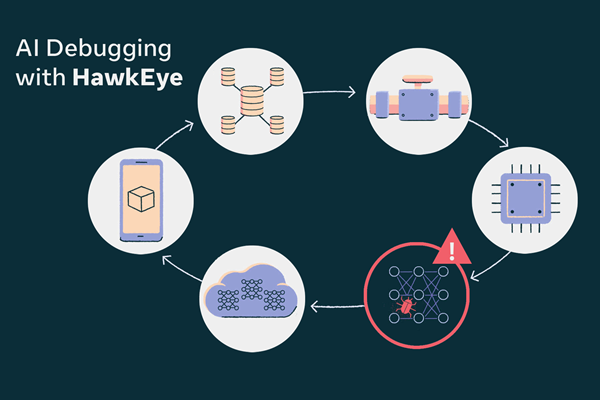Meta Unveils Generative AI Debugging Toolkit HawkEye
 Meta has created a new AI debugging toolkit called HawkEye to address the growing challenges of monitoring and troubleshooting its machine-learning models in production. With AI now core to Meta’s products and advertising systems, debugging issues demands substantial coordination across teams. HawkEye aims to simplify these workflows by introducing a branching decision system for swiftly identifying and resolving anomalies.
Meta has created a new AI debugging toolkit called HawkEye to address the growing challenges of monitoring and troubleshooting its machine-learning models in production. With AI now core to Meta’s products and advertising systems, debugging issues demands substantial coordination across teams. HawkEye aims to simplify these workflows by introducing a branching decision system for swiftly identifying and resolving anomalies.
HawkEye AI
Meta designed HawkEye as a toolkit that can identify and solve problems in AI models more quickly. That includes when models degrade, hallucinate, or start making erratic predictions. Previously, debugging machine learning at Meta required specialized knowledge and extensive manual analyses. Engineers collaborated across notebooks to pinpoint root causes, costing significant time and effort. HawkEye replaces this reactive process with proactive guardrails and automated diagnostics. Its simplified approach reduces the time from detecting problems to implementing fixes.
“HawkEye implements a decision tree that streamlines this process while building the necessary components for continuous instrumentation and analysis layers to build the tree. HawkEye enables users to efficiently navigate the decision tree and quickly identify the root cause of complex issues,” Meta’s researchers explained in their research. “As a result, HawkEye has significantly reduced the time spent on debugging complex production issues, simplified operational workflows, and enabled non-experts to triage complex issues with minimal coordination and assistance.”
The toolkit provides systematic guidance for tackling anomalies in key metrics. Users follow the decision trees to isolate factors like infrastructure, traffic, or model versions. On-call staff can then assess prediction quality across experiments and pinpoint any degradation. HawkEye further narrows down root causes by leveraging advanced model explainability algorithms. These identify input features that correlate with prediction distribution anomalies. Engineers receive actionable ranked lists of features needing fixes to resolve issues swiftly.
Meta is aiming HawkEye to eliminate problems before they become visible. Instead of developers having to wait for issues to escalate and start impacting user experiences, HawkEye spots and removes any issue it can, leaving only the more complex or systemic problems for human developers to tackle. Meta plans to continue improving HawkEye’s flexibility to handle new and evolving debugging challenges. Extensibility features and open-source community initiatives will facilitate continuous enhancement.
Meta AI Strategy
Meta believes HawkEye represents a pivotal advancement in operational AI. As machine learning assumes greater importance across its apps and platforms, HawkEye provides the guardrails and diagnostics needed at scale. The debugging efficiencies will allow Meta to accelerate the development and deployment of AI-powered features. With HawkEye, the company aims to enhance reliability as AI complexity increases across its vast production ecosystem. Meta claims that open-sourcing HawkEye will move the entire industry forward in robust, responsible AI operations.
That’s certainly likely internally, considering how much Meta has centered its various businesses around generative AI. Most recently, the company widened the availability of generative AI tools on its social media platforms after unveiling a stable of LLM-powered conversational AI chatbots for its messaging services. Meta AI and the other chatbots employ a version of Meta’s Llama 2 LLM enhanced by some of its recent research.
Follow @voicebotaiFollow @erichschwartz
Meta Expands Generative AI Features to Social Media and Teases Invisible Watermarking
Meta Introduces Generative AI Chatbot Assistant and a Cast of Celebrity Chatbot Characters








